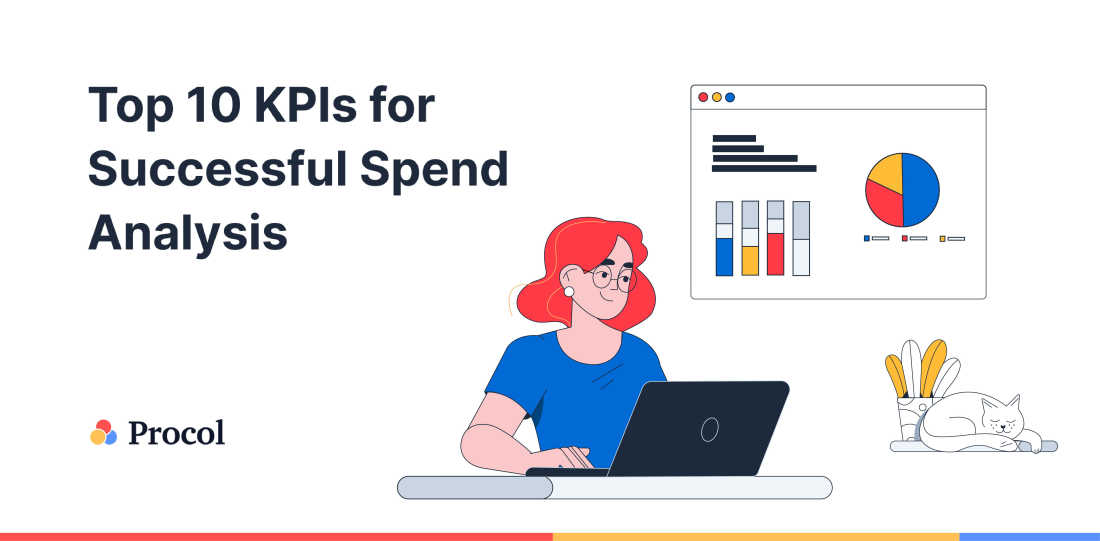Top 10 KPIs for Successful Spend Analysis

TABLE OF CONTENTS
Measurable statistics used to assess a company’s total long-term effectiveness are called Key Performance Indicators. KPIs, in particular, aid in determining a firm’s operational, financial, and functional successes, particularly when contrasted to competitors. They assess a company’s effectiveness compared to a series of aims, goals, or industry competitors.
Financial KPIs include net income, revenues minus specific costs, and liquidity ratios. Customer-centric KPIs often focus on per-customer productivity, client happiness, and customer turnover. According to research, lowering rogue expenditure by 5-10% may save the typical large business several million dollars.
Key Performance Indicators for Successful Spend Management Analysis
1. Savings
That’s relatively easy and perhaps a little apparent, so you set it first. To determine your techniques’ success, select a proportion of actual savings from year to year. When you do not possess a year of information to compare yourself to, it’s fine to examine savings month by month. But remember to consider seasonality, specifically fluctuations unique to your sector.
2. Price Reduction
Savings and cost reduction are not the same thing. Whereas cost savings seek methods to decrease the price of products and systems, cost reduction aims to eliminate needless expenditures by reducing those services and products. Identify current savings made by lowering services and products compared to historical expenses.
3. Price Avoidance
Price avoidance is critical for production, commerce, life sciences, or medical firms. This KPI calculates the sum of money you saved by avoiding unneeded replacements, repairs, or damages. Consider the savings achieved by suitable materials monitoring (which eliminates the need to discard outdated supplies), tool care (which eliminates costly failures), or stock control (this prevents overstocking and hasty orders).
4. Total Management Spend
Total expenditure under management seems to be the proportion of your company’s spending constantly managed by the procurement system. Determine your overall cost under the management objective, considering your overall addressable expense.
The second significant metric, maverick spending, immediately conflicts with expense under spend management. When determining your SUM KPI, consider the following: Is it inclusive of indirect and direct materials, as well as MRO (Maintenance, Repair, and Overhaul)? Is it applicable to all corporate units?
5. Maverick Spending
Determine a percentage reduction in maverick spending or an appropriate amount of maverick spending. You’ll often wish to keep your maverick expenditure as low as possible.
Maverick spending is the most significant danger to a good strategy for several procurement software groups since it avoids the contract management system your group placed so much effort into acquiring. A recent study highlighted that over 54% of staff members admit to making purchases without passing the required authorisation procedures.
6. Total Spending Contribution
Contribution to overall expenditure refers to determining where your funds are going, whether it’s on particular things, categories, or vendors. Setting KPIs to track such contributions is crucial since it allows you to find savings possibilities. Two examples are establishing a new contract management system with the high-volume vendor, for instance, or concentrating spending on popular commodities on only one vendor to capitalise on buying power.
7. Agreement Pricing & Agreement Compliance
Agreement compliance is critical to the e-procurement company’s performance. Establish a KPI to guarantee that contract management system pricing is preserved on both the supplier and buyer sides. Suppliers are required to provide you with an agreed-upon price, and it is as necessary for buyers around your business to do the same.
8. PPV (Purchase Price Variance)
Set a KPI to track and control buy price fluctuation. The PPV is the gap between the costs you expect to spend and the actual price of products when you buy them. Variance might be caused by outdated pricing documents, changing vendors, urgent orders, incorrect volume estimations, or other incorrect projections. By lowering the PPV, you may consider more precisely forecast spending & budget more wisely.
9. Supplier Administration
Supplier administration is an essential topic with several KPIs that may be identified. To begin, you propose establishing a measure to guarantee that a given amount of your expenditure is routed via a specific percentage of your vendors. Consider starting with the numbers in Pareto Principles - 80/20. Approximately 80% of your expenditure should be routed through 20% of your vendors.
10. Supplier Efficiency
Another vendor administration KPI, supplier performance, must oversee a provider’s dependability and consistency. This statistic should assess the performance of suppliers in terms of pricing, quality, delivery, and service.
Supplier efficiency concerns might be evident sometimes, but they can also be sporadic and difficult to recognise. The KPI may assist you in identifying vulnerabilities in your distribution network so you can locate other sources of supplies.
Procol is a procurement software that can ease a business’ purchase process with automation. It is both agile and responsive, making it easy to use. Schedule a demo to understand its flexibility for your business and procurement needs.
Get a Free Demo
We'd love to hear from you. Please fill out this form to schedule a demo with us. You can also give a call on +91 76666 82222



